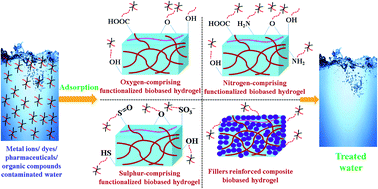Functional biobased hydrogels for the removal of aqueous hazardous pollutants: current status, challenges, and future perspectives
Abstract
Contaminated water and scarcity of clean water are serious global environmental concerns. Elimination of hazardous organic/inorganic contaminants from water/sewages is essential and demands immediate attention in order to protect pure water resources. Adsorptive decontamination of aqueous pollutants is widely accepted technology owing to its simple handling, higher efficiency and economic viability. Functionalized natural polymeric materials such as cellulose, biomass, starch, proteins, and biochar have been considered as highly effective adsorbents for the elimination of aqueous pollutants, in particular heavy metal ions, textile dyes, pharmaceuticals and hazardous organic compounds. Biobased hydrogels fabricated via introduction of oxygen, nitrogen and sulphur comprising groups and inorganic fillers (graphene, clay, carbon nanotubes, etc.) are attractive materials owing to their distinctive physicochemical properties, cost-effectiveness, ease of fabrication and operation, large specific surface area and porosity, and easy reusability. Functional biobased hydrogels showed superior adsorption performance for cationic contaminants via electrostatic and hydrogen (H)-bonding interactions. This review summarizes state-of-the-art biobased hydrogels including their intrinsic properties, previous and recent advances and future tactics for their use in wastewater treatment applications. Fabrication methods and properties of modified biobased hydrogels and their adsorption characteristics are specially focused. Development of biobased hydrogels with desirable properties such as three-dimensional (3D) microstructure, high porosity and surface area and multifunctionality is a potential way to fulfill the expanding demands of wastewater treatment at an industrial scale. The current position of invention and utilization of biobased hydrogels in wastewater treatment is reviewed without ignoring iconic studies that have advanced this area of research to the current stage. Eventually, future perspectives for the development of advanced biobased hydrogels to overcome separation problems and move towards new technological aspects are also described.



 Please wait while we load your content...
Please wait while we load your content...